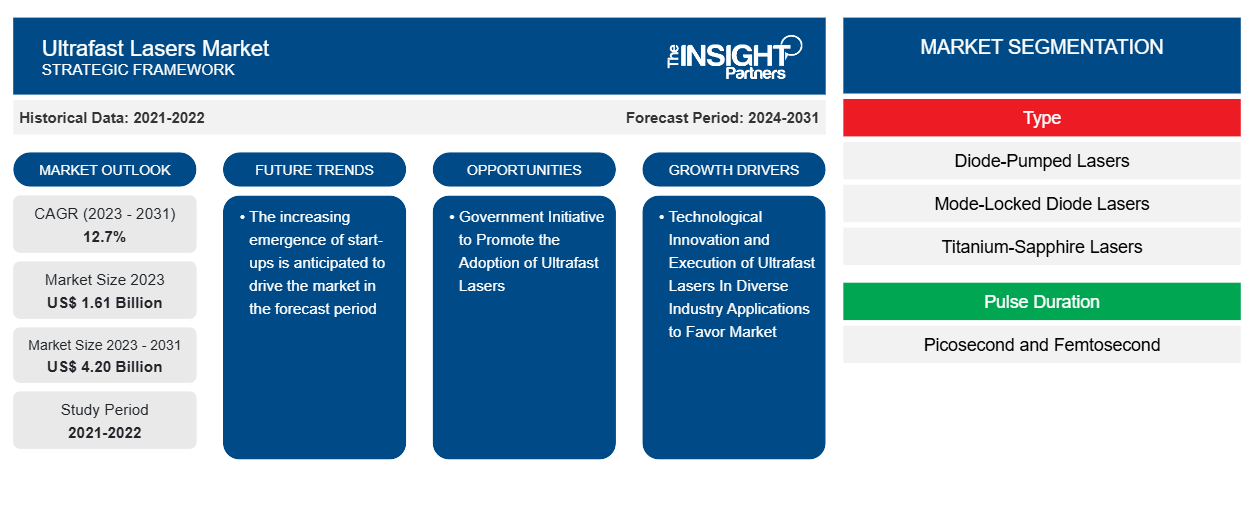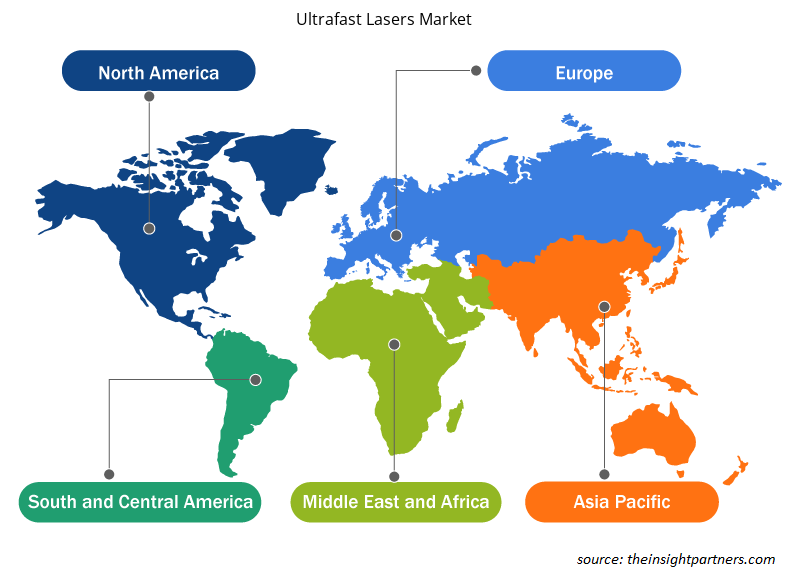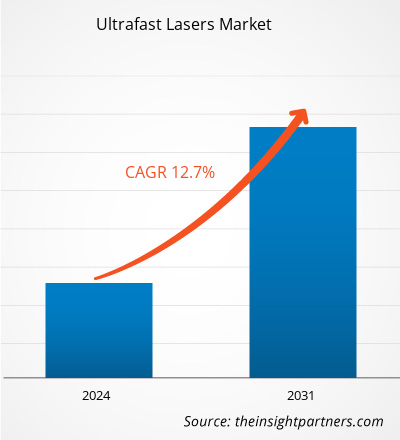The ultrafast lasers market size is projected to reach US$ 4.20 billion by 2031 from US$ 1.61 billion in 2023. The market is expected to register a CAGR of 12.7% during 2023–2031. Increasing technological innovations and the implementation of ultrafast lasers in diverse industry applications are likely to remain key trends and drivers in the market.
Ultrafast Lasers Market Analysis
The ultrafast lasers market is experiencing significant growth globally. The growth is attributed to parameters such as increasing technological innovations and the implementation of ultrafast lasers in diverse industry applications. Moreover, expanding applications of laser technology and the growing emergence of start-ups are anticipated to hold several opportunities for the market.
Ultrafast Lasers Market Overview
Ultrafast lasers are identified to generate very short light pulses, commonly of the order of femtoseconds or picoseconds. Ultrafast lasers are founded on techniques like mode-locking to form a train of pulses and have newly been successful due to the new advancements in photonics. Such developments in laser technology have allowed the generation of pulses reaching between a few femtoseconds to tens of attoseconds.
Customize This Report To Suit Your Requirement
You will get customization on any report - free of charge - including parts of this report, or country-level analysis, Excel Data pack, as well as avail great offers and discounts for start-ups & universities
Ultrafast Lasers Market: Strategic Insights

- Get Top Key Market Trends of this report.This FREE sample will include data analysis, ranging from market trends to estimates and forecasts.
You will get customization on any report - free of charge - including parts of this report, or country-level analysis, Excel Data pack, as well as avail great offers and discounts for start-ups & universities
Ultrafast Lasers Market: Strategic Insights

- Get Top Key Market Trends of this report.This FREE sample will include data analysis, ranging from market trends to estimates and forecasts.
Ultrafast Lasers Market Drivers and Opportunities
Technological Innovation and Execution of Ultrafast Lasers In Diverse Industry Applications to Favor Market.
Technological innovation and execution of ultrafast lasers in diverse industry applications are indeed driving the market growth. Ultrafast lasers are used in industries such as consumer electronics, industrial, automotive, and medical & scientific, and others. Ultrafast lasers can be useful for needs in the automotive industry. This comprises the structuring of small furrows into the surface of the cylinder wall of a combustion engine. This guarantees a thorough distribution of lubricant along the piston wall to minimize friction loss. It also presents a review of the modern advances in ultrafast laser-based manufacturing processes, some of the most interesting industrial applications, and a discussion on future trends and challenges. Thus, considering the above parameters, the increasing technological innovation and implementation of ultrafast lasers in diverse industry applications is driving the ultrafast lasers market growth.
Government Initiative to Promote the Adoption of Ultrafast Lasers.
The rising number of government initiatives to promote the adoption of ultrafast lasers is anticipated to hold several opportunities for the ultrafast lasers market. The training of a highly qualified next generation of talents is a crucial issue in several fields, and research is no exception. Drawing on his experience in the scientific and academic communities, in April 2023, NSERC set up an ambitious project to initiate a sustainable learning ecosystem in the field of ultrafast laser science and technology. NSERC offered US$1.65 million for the next generation of talents in the field of ultrafast laser science and technology.
Ultrafast Lasers Market Report Segmentation Analysis
Key segments that contributed to the derivation of the ultrafast lasers market analysis are type, pulse duration, and application.
- Based on type, the ultrafast lasers market is divided into diode-pumped lasers, mode-locked diode lasers, titanium-sapphire lasers, and fiber lasers. The diode-pumped lasers segment is anticipated to hold a significant market share in the forecast period.
- Based on pulse duration, the ultrafast lasers market is divided into picosecond and femtosecond. The picosecond segment is anticipated to hold a significant market share in the forecast period.
- By applications, the market is segmented into consumer electronics, industrial, automotive, and medical & scientific. The consumer electronics segment is anticipated to hold a significant market share in the forecast period.
Ultrafast Lasers Market Share Analysis by Geography
The geographic scope of the ultrafast lasers market report is mainly divided into five regions: North America, Asia Pacific, Europe, Middle East & Africa, and South & Central America.
North America has dominated the ultrafast lasers market. High technology adoption trends in various industries in the North American region have fuelled the growth of the ultrafast lasers market. Factors such as increased adoption of digital tools and high technological spending by government agencies are expected to drive the North American ultrafast lasers market growth. Moreover, a strong emphasis on research and development in the developed economies of the US and Canada is forcing the North American players to bring technologically advanced solutions into the market. In addition, the US has a large number of ultrafast laser market players who have been increasingly focusing on developing innovative solutions. All these factors contribute to the region's growth of the ultrafast lasers market.
Ultrafast Lasers Market Regional Insights
The regional trends and factors influencing the Ultrafast Lasers Market throughout the forecast period have been thoroughly explained by the analysts at Insight Partners. This section also discusses Ultrafast Lasers Market segments and geography across North America, Europe, Asia Pacific, Middle East and Africa, and South and Central America.

- Get the Regional Specific Data for Ultrafast Lasers Market
Ultrafast Lasers Market Report Scope
| Report Attribute | Details |
|---|---|
| Market size in 2023 | US$ 1.61 Billion |
| Market Size by 2031 | US$ 4.20 Billion |
| Global CAGR (2023 - 2031) | 12.7% |
| Historical Data | 2021-2022 |
| Forecast period | 2024-2031 |
| Segments Covered |
By Type
|
| Regions and Countries Covered | North America
|
| Market leaders and key company profiles |
Ultrafast Lasers Market Players Density: Understanding Its Impact on Business Dynamics
The Ultrafast Lasers Market is growing rapidly, driven by increasing end-user demand due to factors such as evolving consumer preferences, technological advancements, and greater awareness of the product's benefits. As demand rises, businesses are expanding their offerings, innovating to meet consumer needs, and capitalizing on emerging trends, which further fuels market growth.
Market players density refers to the distribution of firms or companies operating within a particular market or industry. It indicates how many competitors (market players) are present in a given market space relative to its size or total market value.
Major Companies operating in the Ultrafast Lasers Market are:
- Amplitude Systemes
- Coherent Inc.
- Dpss Laser Inc.
- Femtolasers Productions Gmbh
- Fianiijm Ltd
- Huaray Laser
Disclaimer: The companies listed above are not ranked in any particular order.

- Get the Ultrafast Lasers Market top key players overview
Ultrafast Lasers Market News and Recent Developments
The ultrafast lasers market is evaluated by gathering qualitative and quantitative data post primary and secondary research, which includes important corporate publications, association data, and databases. A few of the developments in the ultrafast lasers market are listed below:
- MKS Instruments, Inc. introduced its Spectra-Physics IceFyre FS IR200 laser, an industrial femtosecond laser offering >200 W power and >200 µJ pulse energy with ultrashort <500 fs pulses in the infrared (IR). (Source: MKS Instruments, Inc, Company Website, June 2023)
- Chromacity announced a strategic partnership agreement with Edmund Optics for the global supply and distribution of its ultrafast lasers. The announcement coincides with the launch of Chromacity’s latest ultrafast laser emitting light at 920 nm. (Source: Chromacity Company Website, February 2024)
Ultrafast Lasers Market Report Coverage and Deliverables
The “Ultrafast Lasers Market Size and Forecast (2021–2031)” report provides a detailed analysis of the market covering below areas:
- Ultrafast lasers market size and forecast at global, regional, and country levels for all the key market segments covered under the scope.
- Ultrafast lasers market trends as well as market dynamics such as drivers, restraints, and key opportunities.
- Detailed PEST/Porter’s Five Forces and SWOT analysis.
- Ultrafast lasers market analysis covering key market trends, global and regional framework, major players, regulations, and recent market developments.
- Industry landscape and competition analysis covering market concentration, heat map analysis, prominent players, and recent developments for the ultrafast lasers market.
- Detailed company profiles.
Frequently Asked Questions
What are the future trends of the ultrafast lasers market?
The increasing emergence of start-ups is anticipated to drive the market in the forecast period.
Which are the leading players operating in the ultrafast lasers market?
The key players holding majority shares in the global ultrafast lasers market are Amplitude Systemes, Coherent Inc., Dpss Laser Inc., Femtolasers Productions Gmbh, Fianiijm Ltd, Huaray Laser, Jenoptik Ag, Kmlabs, Laser Quantum Ltd, Viavi Solutions.
Which region dominated the ultrafast lasers market in 2023?
North America is anticipated to dominate the ultrafast lasers market in 2023.
What are the driving factors impacting the ultrafast lasers market?
Increasing technological innovations and the implementation of ultrafast lasers in diverse industry applications are some of the factors driving the ultrafast lasers market.
What would be the estimated value of the ultrafast lasers market by 2031?
The global ultrafast lasers market is expected to reach US$ 4.20 billion by 2031.
What is the expected CAGR of the ultrafast lasers market?
The expected CAGR of the ultrafast lasers market is 12.7%.
- Historical Analysis (2 Years), Base Year, Forecast (7 Years) with CAGR
- PEST and SWOT Analysis
- Market Size Value / Volume - Global, Regional, Country
- Industry and Competitive Landscape
- Excel Dataset
Testimonials
I wish to appreciate your support and the professionalism you displayed in the course of attending to my request for information regarding to infectious disease IVD market in Nigeria. I appreciate your patience, your guidance, and the fact that you were willing to offer a discount, which eventually made it possible for us to close a deal. I look forward to engaging The Insight Partners in the future, all thanks to the impression you have created in me as a result of this first encounter.
DR CHIJIOKE ONYIA, MANAGING DIRECTOR, PineCrest Healthcare Ltd.The Insight Partners delivered insightful, well-structured market research with strong domain expertise. Their team was professional and responsive throughout. The user-friendly website made accessing industry reports seamless. We highly recommend them for reliable, high-quality research services
Yukihiko Adachi CEO, Deep Blue, LLC.Reason to Buy
- Informed Decision-Making
- Understanding Market Dynamics
- Competitive Analysis
- Customer Insights
- Market Forecasts
- Risk Mitigation
- Strategic Planning
- Investment Justification
- Identifying Emerging Markets
- Enhancing Marketing Strategies
- Boosting Operational Efficiency
- Tracking Industry Innovations
- Aligning with Regulatory Trends
Yes! We provide a free sample of the report, which includes Report Scope (Table of Contents), report structure, and selected insights to help you assess the value of the full report. Please click on the "Download Sample" button or contact us to receive your copy.
Absolutely — analyst assistance is part of the package. You can connect with our analyst post-purchase to clarify report insights, methodology or discuss how the findings apply to your business needs.
Once your order is successfully placed, you will receive a confirmation email along with your invoice.
• For published reports: You’ll receive access to the report within 4–6 working hours via a secured email sent to your email.
• For upcoming reports: Your order will be recorded as a pre-booking. Our team will share the estimated release date and keep you informed of any updates. As soon as the report is published, it will be delivered to your registered email.
We offer customization options to align the report with your specific objectives. Whether you need deeper insights into a particular region, industry segment, competitor analysis, or data cut, our research team can tailor the report accordingly. Please share your requirements with us, and we’ll be happy to provide a customized proposal or scope.
The report is available in either PDF format or as an Excel dataset, depending on the license you choose.
The PDF version provides the full analysis and visuals in a ready-to-read format. The Excel dataset includes all underlying data tables for easy manipulation and further analysis.
Please review the license options at checkout or contact us to confirm which formats are included with your purchase.
Our payment process is fully secure and PCI-DSS compliant.
We use trusted and encrypted payment gateways to ensure that all transactions are protected with industry-standard SSL encryption. Your payment details are never stored on our servers and are handled securely by certified third-party processors.
You can make your purchase with confidence, knowing your personal and financial information is safe with us.
Yes, we do offer special pricing for bulk purchases.
If you're interested in purchasing multiple reports, we’re happy to provide a customized bundle offer or volume-based discount tailored to your needs. Please contact our sales team with the list of reports you’re considering, and we’ll share a personalized quote.
Yes, absolutely.
Our team is available to help you make an informed decision. Whether you have questions about the report’s scope, methodology, customization options, or which license suits you best, we’re here to assist. Please reach out to us at sales@theinsightpartners.com, and one of our representatives will get in touch promptly.
Yes, a billing invoice will be automatically generated and sent to your registered email upon successful completion of your purchase.
If you need the invoice in a specific format or require additional details (such as company name, GST, or VAT information), feel free to contact us, and we’ll be happy to assist.
Yes, certainly.
If you encounter any difficulties accessing or receiving your report, our support team is ready to assist you. Simply reach out to us via email or live chat with your order information, and we’ll ensure the issue is resolved quickly so you can access your report without interruption.





















 Get Free Sample For
Get Free Sample For